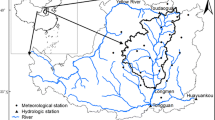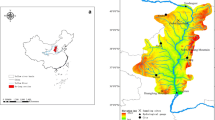Abstract
Riverine sediment load, a reflection of basin erosion and sediment yield, is influenced by both climatic and human factors. Complex interaction between various factors within a basin dampens and counteracts the forces that drive sediment variations. The gross human impact index and the index estimation method have both been proposed to reflect the impacts of human activities on soil erosion and sediment yield. Sediment load and daily rainfall data from 1955 to 2010 in the upper Yangtze basin, and in the Wu, Jialing, Min and Jinsha subbasins, were collected to assess the human versus climatic impacts on sediment yield. From 1955 to 2010, the average annual runoff in the study area was 428.2 billion m3, and the average annual suspended sediment load was approximately 0.43 billion t. There was a critical point in 1984, 1985, 1991, 1993 and 1999 when the sediment load decreased in the Wu, Jialing, upper Yangtze, Min and Jinsha river, respectively. The annual regional rainfall erosivities in the upper Yangtze basin in most years ranged between 2,500 and 3,500 MJ mm hm−2 h−1 year−1 and fluctuated around 3,000 MJ mm hm−2 h−1 year−1 with a small coefficient of variation of 0.11. In the Jinsha subbasin, the index indicated that increasing rainfall erosivity could not account for the reduction in riverine sediment load and that anthropogenic erosion-control measures played a key role. The index values for the Min, Jialing and Wu subbasins ranged from 76 to 97 % and for the upper Yangtze basin is 95 %, demonstrating the joint effects of precipitation and human activities in all basins, with erosion-controlling measures playing a major role in sediment load reduction.





Similar content being viewed by others
References
Ai NS, Xu JH (1988) Study on the effect of human activities on soil erosion analysis method. J Soil Water Conserv 10:46–48 (in Chinese)
An J, Zheng FL, Romkens MJM, Li GF, Yang QA, Wen LL, Wang B (2013) The role of soil surface water regimes and raindrop impact on hillslope soil erosion and nutrient losses. Nat Hazards 67:411–430
Arnalds O, Barkarson BH (2003) Soil erosion and land-use policy in Iceland in relation to sheep grazing and government subsidies. Environ Sci Policy 6(1):105–113
Cai QG, Fan HM (2004) On the factors and prediction models of SDR. Prog Geogr 23(5):1–9 (in Chinese)
Dai SB, Lu XX (2013) Sediment load change in the Yangtze River (Changjiang): a review. Geomorphology. doi:10.1016/j.geomorph.2013.05.027
Dai SB, Yang SL, Cai AM (2007) Variation of sediment discharge of the Pearl River from 1955 to 2005. Acta Geogr Sin 62(5):545–554 (in Chinese)
Du J, Shi CX, Fan XL, Zhou YY (2011) Impacts of socio-economic factors on sediment yield in the Upper Yangtze River. J Geogr Sci 21(2):359–371
Fan SY, Xu JH (1992) General mathematical model of soil erosion and desertification in the humanities and the role of quantitative analysis. Geogr Sci 12(4):305–312 (in Chinese)
Gao P, Mu XM, Wang F, Li R (2011) Changes in streamflow and sediment discharge and the response to human activities in the middle reaches of the Yellow River. Hydrol Earth Syst Sci 15:1–10
Higgitt DL, Lu XX (1999) Challenges in relating land use to sediment yield in the Upper Yangtze. Hydrobiologia 410:269–277
Lane LJ, Hernandez M, Nichols M (1997) Processes controlling sediment yield from watersheds as functions of spatial scale. Environ Model Softw 12:355–369
Li CX, Yang SY, Fan DD, Zhao J (2004) The change in Changjiang suspended load and its impact on the delta after completion of Three Gorges Dam. Quat Sci 24:495–500 (in Chinese)
Li QF, Yu MX, Lu GB, Cai T, Bai X, Xia ZQ (2011) Impacts of the Gezhouba and Three Gorges reservoirs on the sediment regime in the Yangtze River, China. J Hydrol 403:224–233
Liu C, Sui JY, He Y, Hirshfield F (2013) Changes in runoff and sediment load from major Chinese rivers to the Pacific Ocean over the period 1955–2010. Int J Sediment Res 28:486–495
Loureiro NS, Coutinho MA (2001) A new procedure to estimate the RUSLE EI30 index based on monthly rainfall data and applied to the Algarve region, Portugal. J Hydrol 250:12–18
Lu XX (2005) Spatial variability and temporal changed of water discharge and sediment flux in the lower Jinsha tributary: impact of environmental changes. River Res Appl 21:229–243
Lu XX, Ashmore P, Wang J (2003) Sediment yield mapping in a large river basin: the Upper Yangtze, China. Environ Model Softw 18:339–353
Lu XX, Ran LS, Liu S, Jiang T, Zhang SR, Wang JJ (2013) Sediment loads response to climate change: a preliminary study of eight large Chinese rivers. Int J Sediment Res 28:1–14
Luo XL, Zeng EY, Ji RY, Wang CP (2007) Effects of in-channel sand excavation on the hydrology of the Pearl River Delta, China. J Hydrol 343:230–239
Mao DZ, Cherkauer Keith A (2009) Impacts of land use change on hydrologic response in the Great Lakes region. J Hydrol 374:71–82
Miao CY, Ni JR, Borthwick AGL, Yang L (2011) A preliminary estimate of human and natural contributions to the changes in water discharge and sediment load in the Yellow River. Global Planet Change 76:196–205
Ranzi R, Le TH, Rulli MC (2012) A RUSLE approach to model suspended sediment load in the Lo river (Vietnam): effects of reservoirs and land use changes. J Hydrol 422(423):17–29
Shi CX, Du J (2009) Causes for stepped changes of sediment load in the upper Yangtze River. J Sediment Res 4:16–24 (in Chinese)
Song CF, Tao HP, Liu BT, Shi Z, Guo B, Hua J (2012) Spatial distribution characteristics of soil erodibility K value in the Upper Yangtze river. Resour Environ Yangtze Basin 21(9):1123–1130 (in Chinese)
Sun CJ, Sun Y, Wang L (2007) Analysis of impact of human activities to water and sand in Liuhe River. J Water Resour Water Eng 18(3):98–100 (in Chinese)
Tang Q, He XB, Bao YH, Zhang XB, Guo F, Zhu HW (2013) Determining the relative contributions of climate change and multiple human activities to variations of sediment regime in the Minjiang River, China. Hydrol Process 27:3547–3559
The Ministry of Water Resources (2011) Chinese River Sediment Bulletin 2010. China Water Power Press (in Chinese)
Verstraeten G, Lang A, Houben P (2009) Human impact on sediment dynamics—quantification and timing. Catena 77:77–80
Walling DE (2006) Human impact on land–ocean sediment transfer by the world’s rivers. Geomorphology 79(3/4):192–216
Walling DE, Fang D (2003) Recent trends in the suspended sediment loads of the world rivers. Global Planet Change 39:111–126
Wang LL, Yao WY, Liu LY, Li M (2008) Research progress of sediment delivery ratio in our country. Yellow River 30(9):36–37 (in Chinese)
Wei J, He XB, Bao YH (2011) Anthropogenic impacts on suspended sediment load in the Upper Yangtze River. Reg Environ Change 11:857–868
Wen AB, Zhang XB, Wang YK, Feng MY, Zhang YY, Xu JY, Bai LX, He TR, Wang JW (2002) Study on soil erosion rates using 137Cs technique in upper Yangtze river. J Soil Water Conserv 16:1–3 (in Chinese)
Wischmeier WH, Smith DD (1958) Rainfall energy and its relationship to soil loss. EOS Trans AGU 39(3):285–291
Xin ZB, Xu JX, Yu XX (2009) Temporal and spatial variability of sediment yield on the Loess Plateau in the past 50 years. Acta Ecol Sin 29(3):1129–1139 (in Chinese)
Xin ZB, Yu XX, Li QY, Lu XX (2010) Spatiotemporal variation in rainfall erosivity on the Chinese Loess Plateau during the period 1956–2008. Reg Environ Change 11:149–159
Xu JX (2007) Trends in suspended sediment size in the upper Yangtze River and its tributaries, as influenced by human activities. Hydrol Sci J 52:777–792
Xu KH, Milliman JD (2009) Seasonal variations of sediment discharge from the Yangtze River before and after impoundment of the Three Gorges Dam. Geomorphology 104(3/4):1–8
Xu QX, Shi GY, Chen ZF (2004) Analysis of recent changing characteristics and tendency runoff and sediment transport in the upper reach of Yangtze River. Adv Water Sci 15(4):420–426 (in Chinese)
Yang SL, Li M, Dai SB, Liu Z, Zhang J, Ding PX (2006) Drastic decrease in sediment supply from the Yangtze River and its challenge to coastal wetland management. Geophys Res Lett 33:L06408. doi:10.1029/2005GL025507
Yang SL, Milliman JD, Li P, Xu K (2011) 50000 dams later: erosion of the Yangtze River and its delta. Global Planet Change 75:14–20
Yin S, Xie Y, Nearing MA, Wang C (2007) Estimation of rainfall erosivity using 5- to 60-minute fixed-interval rainfall data from China. Catena 70:306–312
Yu B, Rosewell CJ (1996a) An assessment of a daily rainfall erosivity model for New South Wales. J Soil Res 34:139–152
Yu B, Rosewell CJ (1996b) A robust estimator of the R-factor for the universal soil loss equation. Trans ASAE 39:559–561
Zhang WB, Fu JS (2003) Rainfall erosivity estimation under different rainfall amount. Resour Sci 25(1):35–41 (in Chinese)
Zhang XB, Wen AB (2004) Current changes of sediment yields in the upper Yangtze River and its two biggest tributaries, China. Global Planet Change 41:221–227
Zhang KL, Li S, Peng W, Yu BF (2004) Erodibility of agricultural soils on the Loess Plateau of China. Soil Tillage Res 76:157–165
Zhu YM, Lu XX, Zhou Y (2008) Sediment flux sensitivity to climate change: a case study in the Longchuan catchment of the upper Yangtze River, China. Glob Planet Change 60(3/4):429–442
Acknowledgments
We warmly thank the reviewers for their insightful comments and helpful suggestions. This study is finically supported by National Key Technology R & D Program (No. 2011BAD31B03), the National Natural Science Foundation of China (No. 41001168), Chongqing Education Committee (No. KJ100601) and the Key Laboratory of Mountain Surface Processes and Ecological Regulation. We are also grateful to the China Meteorological Data Sharing Service System for access to the valuable daily precipitation datasets.
Author information
Authors and Affiliations
Corresponding author
Rights and permissions
About this article
Cite this article
Wei, J., Hou, L. & He, X. An assessment of human versus climatic impacts on large-sized basin erosion: the case of the upper Yangtze River. Nat Hazards 74, 405–420 (2014). https://doi.org/10.1007/s11069-014-1190-8
Received:
Accepted:
Published:
Issue Date:
DOI: https://doi.org/10.1007/s11069-014-1190-8




